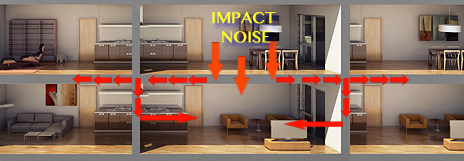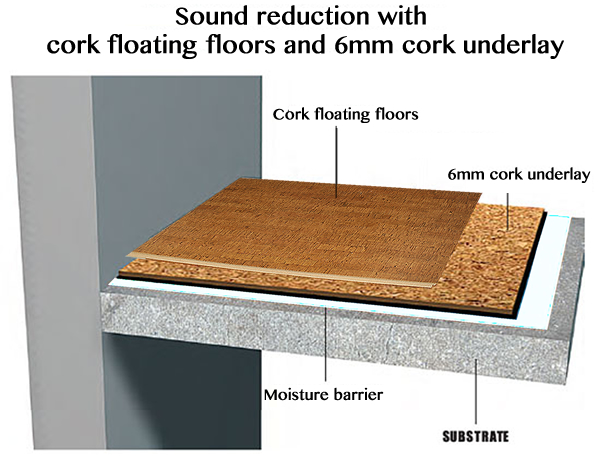How to sound proof insulation, noise reduction a high-rise
Noise and how to deal with it in a home or a high-rise
Noise is one of the biggest complaints we hear about in the building industry. Low noise levels are vital for human health and well-being. Outside noise can make it hard to concentrate on the TV, computer, and even your sleep. We are finding more and more people are looking to cork to help cut down on noise and sound transmissions in their homes.

Before deciding on what product will work best for you, you need to understand the basics about noise and space.
Direct Sound Transmission is when one object strikes another and produces a sound. Like footsteps on the floor, or slamming a door. A good example of Direct Sound Transmission is banging a nail into a wall. One of the most common noise complaints in multifamily units is footsteps. One of the few products that can eliminate footstep noise is carpet. However, carpets cause their own unwanted issues – they can collect dirt and unwanted pests.

When you have a noise that causes part of a building to vibrate it is called Flanking Transmission. This is when the vibration sneaks around joists or studs to enter other spaces. Flanking Transmission is all about moving around the structures and ending up somewhere else. The easiest way for Flanking Transmission to move about a building is through air vents or plumbing pipes. The noise might be from direct transmission (hammering a wall) or from an airborne sound like people talking. This type of transmission is very difficult to find and to correct.
Another common noise is Overhearing, this usually happens through an opening such as an window, an open door or an open-air experience, like dinning on a restaurant patio.
Finally there is Leakage Transmission. This is when noise squeezes underneath things like under doorways or that dead air you find between the drywall and the subfloor. When a door that is left ajar the sound can escape from one room to another that is Leakage sound. Leakage Transmission is the easiest to deal with. Just find the “gaps” and then fill the them with acoustic spray foam. It is common to see acoustic spray-foam applications between drywall and floating floor installations. The foam stops Leakage Transmission from disrupting the room next door.
While sound proofing a room is very difficult, reducing the pathways sound uses to move from one space to another is a little easier.
You can deal with up-down sound transmission from one space to another (Direct Sound Transmission) in three ways. You can upgrade the flooring and underlay (this may include upgrading or thickening the subfloor), upgrading the under pad (includes soft underlayment that runs under hard flooring like cork or rubber underlay) or upgrading the flooring to a sound-reducing form of flooring (carpet, cork or rubber). Carpet is most effective for deadening footsteps but doesn’t cut it when it comes to airborne noise (conversations, TV, home stereo, etc). Solid flooring options will require excessive under pads. This makes the under pad as expensive as the flooring itself. Cork flooring can offer most of the qualities of carpet with the benefit of a solid floor. Cork underlayment is one of the most cost effective forms of flooring sound proof insulation on the market today. A cork floating floor installed over top of cork underlayment offers an “acoustic insulated floor”. Our 6mm cork + 11mm cork floating floor have been tested with NCG Testing in New York. Our floor/underlay combination showed a reduction of 20 dB. Considering that a “good” floor/underlay combo will offer 14 dB, our combination offers excellent value for over price of product.
Insulating a floor is easy, but do you do when walls are the issue? There are plenty of expensive solutions for this on the market today. But you don’t have to go expensive to get the peace and quiet you are looking for.
Regular drywall (5/8”) will add roughly 5 dB of sound proof insulation.
Acoustic Insulation (5/8”) will add about 18bD of sound proof insulation
However, the price point for Acoustic insulation can be triple the cost of regular drywall so most people will away from it. Plus remember that you are adding another sheet onto the existing wall. You also need to use acoustic anchors with the screws, all tied together with acoustic foam/putty prior to painting.
Another option is Green Glue. This acoustic liquid is sandwiched between 2 regular sheets of drywall. Green Glue is NOT an adhesive, it is an additive. You still need drywall screws + acoustic anchors + acoustic putty are the installation. You will need 2 tubes of Green Glue per sheet of drywall to get the maximum benefits. It offers the same benefits as acoustic drywall at a lower cost. You also use regular drywall which helps reduce the overall cost of the project. You will start to notice the benefits of Green Glue within 7 days and maximum benefits after 30 days. This means to have to wait to see if the installation was a complete success.
If time is of the essence, then using acoustic drywall (with proper installation) will give you immediate results. If budget is more important than Green Glue has a slight advantage. A creative way to maintain your design features of your home, while dealing with sound, cork is always an option.
Tests have proven that 4mm cork glue down flooring tiles (can be used on walls, ceilings and floors) will offer a homeowner 14 dB worth of sound proof insulation. Using a 6mm cork tile offers (close to) 18 dB worth of noise control and 8mm cork tiles could be as high as 21-22 dB worth of sound control. With our basic 4mm cork tile offered for $1.99/sf by Cancork Floor or iCork Floor it is easy to see why cork is fast becoming an acoustic design favourite. We offer several 6mm cork tiles for $2.79/sf. This still offers a price benefit to the acoustic drywall or Green Glue + regular drywall. Our 8mm cork tiles can be had for as little as $3.49/sf.
Look to cork tiles for all your sound proof insulation needs.
How to Order
- Ordering Free Sample
- Ordering by Email
- Order Online
Shipping Info
- Pick-up Locations
Contact Info
Tel: 1-604-207-0661
Tel: 1-604-207-9541
Toll Free:
1-877-998-1198
1-866-998-1198
Fax: 1-866-373-6520
Showroom and Warehouse Address:
Cancork Floor INC
#185-1991 Savage Rd.
Richmond BC, V6V 0A4
Canada
About Cork
- Cork Floor Case Study
- Additional Inforemation
Categories
Helpful Links
- Installation
- Measurements and Maintenance
Information
- Info
- Product Information
